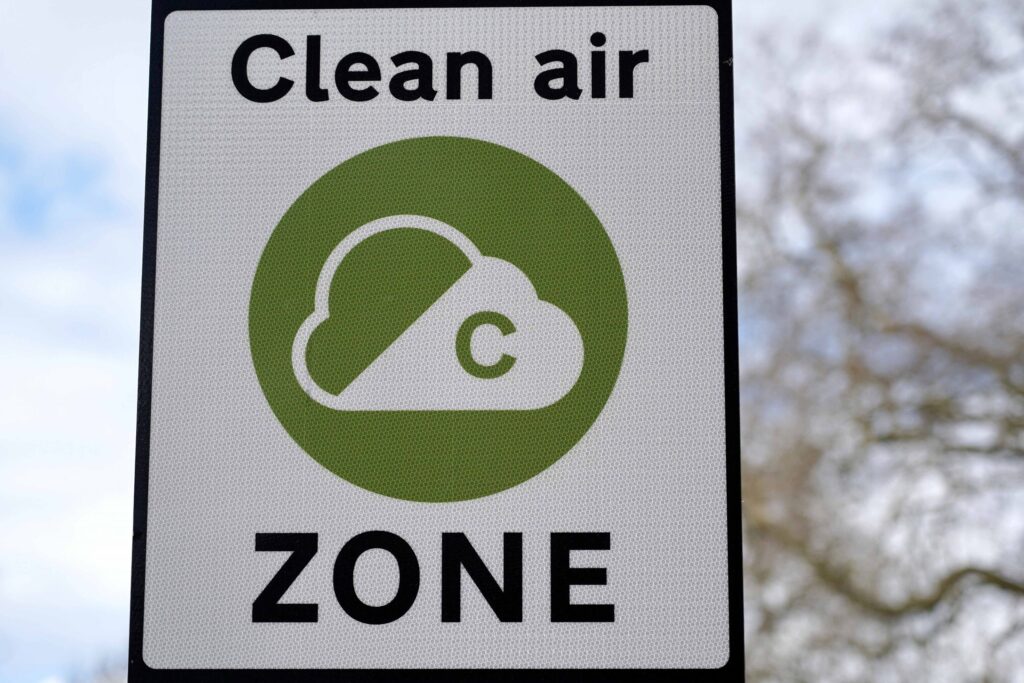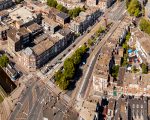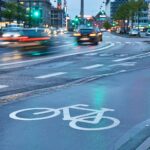
Safer, healthier cities thanks to Smart Urban Traffic Zones
Different zones in the city have different traffic rules and dynamics. The concept of ‘Smart Urban Traffic Zones’ is based on geofencing and employs technology to communicate traffic rules, instructions and other information to vehicles in specific zones. Smart urban traffic zones help to create a flexible city where vehicles travel on people’s terms – not the other way around. Even using existing technology, smart urban traffic zones can be a powerful tool that contributes to quieter, safer and healthier environments for people to live and reside in. New technology means that the number of possible applications for smart urban traffic zones is growing rapidly.
From static road signs to dynamic traffic information
Steden gebruiken het concept van geofencing (of zones) al decennialang, door via verkeersborden informatie te verstrekken over de regels die in een bepaald gebied van kracht zijn, bijvoorbeeld maximumsnelheid, gewichtsbeperkingen, tijdelijke toegangsbeperkingen, parkeerverboden enz. De beschikbaarheid van gps-apparaten in auto’s, vrachtwagens en andere voertuigen maakt het tegenwoordig mogelijk om hun exacte locatie, reisrichting en snelheid te bepalen. Voertuigen die zich in een bepaalde zone bevinden kunnen zone-specifieke informatie ontvangen. Zo kunnen moderne navigatiesystemen en andere in-carsystemen de bestuurders informeren over de maximumsnelheid op de plaats waar zij zijn, en vrachtwagenchauffeurs kunnen in-car-informatie ontvangen over maximale doorrijhoogtes in tunnels.
An obvious next step is to integrate smart urban traffic zones into the concepts of Connected Intelligent Transport Systems (C-ITS), and to use modern telecommunication technology to share digital information with road users. Using real-time traffic data, smart urban traffic zones can provide vehicles with dynamic traffic information, such as warnings about congestion, road works or special events in the zone. At the same time, vehicles on the road can share information with the traffic management center. For instance, heavy trucks can provide info on their payload, which the traffic center can then use to guide them safely through the city.
Toward new geofencing applications
Smart urban traffic zones provide cities and regions with a new set of traffic management controls to manage changing traffic demands. Of course, smart urban traffic zones can also be applied to other modalities, such as pedestrians (e.g., crowd control), cyclists (e.g., optimized green flow) and public transport. For now, the main target group remains motor vehicles; the existing set of static geofences for these can be extended with dynamic variations.
The development of new applications for smart urban traffic zones is well underway, but there are still challenges to face. The greatest of these is probably the introduction of new legislation to include digital traffic management and regulations. The main technological challenge is how moving vehicles can be integrated with the geofencing and traffic management systems. As not all cars and trucks can be connected at once, the further development of smart urban traffic zones in combination with C-ITS will require a phased, step-by-step approach.
- Phase 1: Extension of static geofences with dynamic counterparts and sharing of relevant data with designated users and participants.
- Phase 1: Extension of static geofences with dynamic counterparts and sharing of relevant data with designated users and participants.
- Phase 2: Implementation of new roadside equipment that is visible to all users (e.g., dynamic information panels replacing static speed signs).
- Phase 3: Gradual integration of smart technology into connected cars, trucks and roadside equipment.
- Phase 4: Full integration into all cars and trucks. Integration of other traffic modalities. Replacing existing traffic signs.
With each phase, greater levels of control will become available for the city. At the moment, most projects take place in phase 1. It will depend strongly on local context and available budgets at what point we can move to phase 2. Phase 3 is actually already in progress with the rise of in-car information systems. Phase 4 involves fully automated cars and the use of dynamic geofences to control traffic flows throughout the city by directing them to dynamic corridors.
Successful pilots with smart urban traffic zones
The pan-European SOCRATES2.0 projects and the Swedish NordicWay projects included concepts of smart urban traffic zones. TNL developed the required software as part of MobiMaestro, an extensive, integrated platform for traffic management.
- With respect to smart urban traffic zones, SOCRATES2.0 focused specifically on phase 1: the implementation of environmental geofences, enabling road authorities to ask vehicles to avoid congested areas due to reduced air quality. The feasibility of this concept was demonstrated through successful implementation in Copenhagen.
Two smart urban traffic zone use cases were defined for NordicWay2 in Sweden, and TNL provided the software environment for this with MobiMaestro.
- The first use case was situated in the city of Gothenburg. This phase 3 project focused on environmental urban zones, which could be closed to cars with internal combustion engines (ICE) at specific times. During periods of closure, hybrid vehicles were only allowed to enter the zone if they drove electrically. Using geofencing, participating hybrid cars were able to automatically switch the engine from ICE to electric power when entering the zone. The project showed that Gothenburg could use geofencing to protect particular zones in the city from air pollution, engine noise, etc.
- The second (phase 1) use case was situated near Stockholm and implemented traffic management by dynamic access control. During times of congestion on the highway, a truck could request access to a bus lane that runs parallel to the highway. The traffic management center then determined whether to grant this request, on the basis of regulations, traffic conditions etc.
Upcoming projects like NordicWay3 and the Smart Urban Traffic Zones project will continue to research and develop the implementation of smart zones in other cities and use cases.
Smart Urban Traffic Zones in Stockholm and Gothenburg
As an extension of the NordicWay2 pilot projects mentioned above, the Swedish cities of Stockholm and Gothenburg are participating in other projects that support the development of smart urban traffic zones. The concept is well aligned with Urban Vehicle Access Regulations (UVAR), the European system for regulating access to cities with integrated mobility policies. UVARs are usually aimed at increasing traffic safety and environmental quality in city centers.
TNL realized the technological integration layer for a number of phase-1, 2 and 3 projects that incorporated the concepts of smart urban traffic zones and UVARs.
- Many trucks drive through the center of Stockholm every day. Advanced sensors were installed at busy locations to monitor and count the numbers of pedestrians and cyclists. Based on these data, smart algorithms notify connected trucks to lower their speeds in zones with many pedestrians and/or cyclists.
- Heavy transport vehicles supplying the many construction sites in the Stockholm city center were normally prohibited to use the tunnels around the city center. At specific times, these large trucks may now request permission to use these tunnels. If this is granted, the driver will receive an onboard confirmation. The heavy transport vehicle is now allowed to drive through the tunnel at a reduced speed. The city’s traffic management center will receive automatic notifications when the truck enters and leaves the tunnel, as well as a confirmation of the maximum speed of the truck while driving in the tunnel.
- There was a relatively high incidence of accidents with supply trucks involving pedestrians and cyclists at the entrances of large construction sites in the city of Gothenburg. Sensors were installed at these locations to monitor passing pedestrians and cyclists. When a truck needs to enter or leave the construction site, the driver sends a notification. A portal at the entrance of the site warns pedestrians and cyclists of the approaching vehicle, thereby reducing the risk of accidents.
TNL
TNL has been involved in these and other smart urban traffic zone projects for a long time. In our role as an innovative technology integrator, we are continuously working together with our customers and many different partners to realize smart solutions that will make the city a safer and cleaner place to live, work and play. This can only be done by increasing interconnectivity between the city’s traffic infrastructure and vehicles and other road users. Eventually, smart urban traffic zone solutions will create more breathing space for everyone in the city. Especially for the most vulnerable groups: pedestrians and cyclists.



